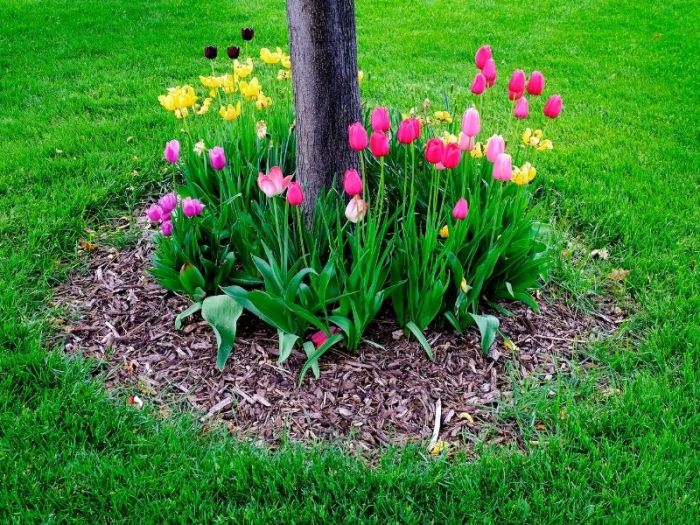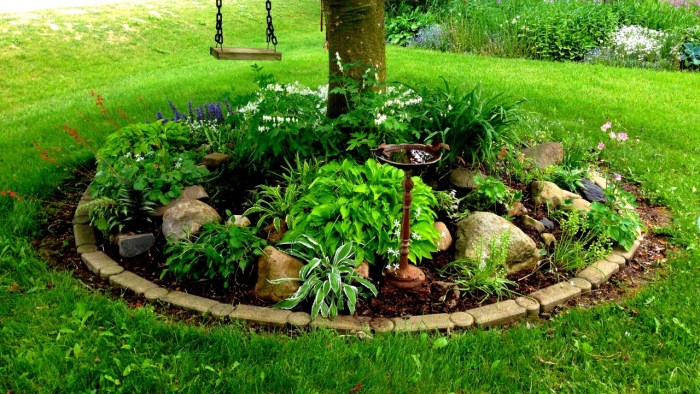How to Plant Around a Tree Successfully
Preparing the Planting Area

How to plant around a tree – Preparing the soil around a tree for new plantings requires careful consideration to avoid damaging the existing root system while creating a suitable environment for the new plants. This involves several key steps, focusing on soil amendment, weed removal, and creating a planting bed that respects the tree’s root zone.
Successful planting around a tree depends heavily on proper soil preparation. Healthy soil promotes vigorous growth for your new plants and minimizes competition with the existing tree. Improper preparation can lead to stunted growth, increased weed pressure, and even damage to the tree’s roots.
Soil Amendment
Soil amendment is crucial for improving soil structure, drainage, and nutrient content. This is especially important if the existing soil is compacted, poorly drained, or lacking in organic matter. Adding compost or other organic matter like well-rotted manure significantly improves soil health. The organic material improves water retention, aeration, and provides nutrients for plant growth. The amount of amendment needed depends on the soil’s existing condition; a soil test can help determine the precise needs.
For example, adding 2-4 inches of compost to a clay soil can dramatically improve its structure and drainage. This allows for better root penetration for both the tree and the new plants.
Weed and Grass Removal
Removing existing weeds and grass is essential to minimize competition for resources with the new plants. However, it’s critical to avoid damaging the tree’s roots during this process. Hand-weeding is the safest method, particularly close to the tree trunk. A sharp trowel or hand fork can carefully remove weeds without disturbing the tree’s roots. For larger areas, consider using a sharp hoe or cultivator, but exercise caution to avoid digging too deeply.
Planting around a tree needs careful consideration of root systems. For example, if you’re planting around a larger tree like the ones shown in a great picture of a rubber tree plant picture of a rubber tree plant , you’ll want to avoid disturbing the roots. Shallow-rooted species require even more space and careful planting to avoid damage.
So always check your tree’s root spread before you dig!
Mulching the area after weeding helps suppress future weed growth and retain soil moisture. A layer of 2-3 inches of organic mulch, such as wood chips or shredded bark, placed several inches away from the tree trunk, is beneficial.
Creating a Planting Bed, How to plant around a tree
Establishing a planting bed that respects the tree’s root zone is vital. Avoid planting directly beneath the tree’s canopy, as this area is often dominated by the tree’s root system. Instead, create planting beds in the outer perimeter of the tree’s drip line (the area under the branches where water drips from the leaves during rain). The size and shape of the planting beds will depend on the size of the tree and the plants you’re adding.
Digging should be shallow, typically no deeper than 12 inches, to prevent root damage. When planting, ensure the new plants are spaced appropriately to prevent overcrowding and competition. For instance, a mature oak tree might have a drip line extending several meters; planting beds should be created within this area, but far enough from the trunk to avoid root conflict.
Planting Techniques

Successful planting around a tree requires careful consideration of plant selection, placement, and technique to ensure the health and longevity of both the tree and the newly planted specimens. Improper planting can lead to competition for resources, hindering growth and potentially damaging the tree’s root system.Planting Techniques for Different Plants Near TreesProper planting techniques vary depending on the type of plant being installed.
Groundcovers, for instance, require different handling than shrubs or smaller trees. Careful consideration of root systems and mature size is crucial to avoid future conflicts.
Groundcover Planting
Groundcovers, due to their low profile and spreading nature, are often a good choice for planting near trees. However, it’s essential to select varieties that are known for their tolerance to shade and limited root competition. When planting, carefully loosen the soil around the tree’s drip line (the area directly beneath the outer branches) to a depth of several inches.
Avoid disturbing the tree’s roots. Create small planting holes, spacing the groundcover plants according to their mature spread, ensuring adequate space for growth without overcrowding. Gently place the plants in the holes, backfill with soil, and water thoroughly. A visual representation would show a person gently placing a groundcover plant into a small hole dug near a tree, avoiding the tree’s trunk and larger roots.
The hole would be small and the soil would appear loose and well-amended.
Shrub Planting
Shrubs require more space than groundcovers and need careful consideration of their mature size. Planting shrubs too close to a tree can lead to significant root competition and stress on both plants. Select shrubs that are appropriate for the light conditions under the tree canopy. Before planting, dig a hole twice as wide and as deep as the shrub’s root ball.
Gently remove the shrub from its container, loosen the roots slightly, and place it in the hole, ensuring the top of the root ball is level with the surrounding soil. Backfill the hole with soil, water thoroughly, and mulch around the shrub, keeping the mulch a few inches away from the tree trunk. An illustrative image would depict a person carefully placing a shrub into a significantly larger hole than the root ball, with the soil appearing loose and ready to receive the plant.
The image would also highlight the appropriate spacing between the shrub and the tree trunk.
Proper Spacing to Avoid Root Competition
The importance of proper spacing cannot be overstated. Overcrowding leads to competition for water, nutrients, and sunlight. This competition can stunt the growth of both the tree and the underplanting, potentially leading to disease and stress. A general rule of thumb is to plant smaller plants at least twice their mature width away from the tree’s trunk. Larger shrubs or small trees may require even greater spacing, depending on the size of the tree and the anticipated growth of the underplanting.
For example, a mature tree with a 10-foot diameter canopy would benefit from shrubs planted at least 20 feet from the trunk. This allows for ample root development without conflict. A diagram showing concentric circles representing the tree’s root zone and the appropriate planting distances for various plant sizes would be beneficial.
Step-by-Step Planting Guide
A step-by-step guide with visual aids can significantly improve planting success. The following process, applicable to most plants, ensures proper technique.
- Site Preparation: Assess the area around the tree, identifying the drip line and any existing roots. Loosen the soil in the selected planting area without damaging the tree’s roots.
- Hole Preparation: Dig a hole that is appropriate for the plant’s size and root system. For shrubs, this is typically twice as wide and deep as the root ball.
- Plant Placement: Gently remove the plant from its container, loosen any circling roots, and place it in the hole at the correct depth. The top of the root ball should be level with the surrounding soil.
- Backfilling: Carefully backfill the hole with soil, ensuring there are no air pockets. Gently firm the soil around the plant.
- Watering: Water the newly planted specimen thoroughly to settle the soil and encourage root establishment.
- Mulching (Optional): Apply a layer of mulch around the plant, keeping it several inches away from the tree trunk. Mulch helps retain moisture and suppress weeds.
Detailed FAQs: How To Plant Around A Tree
What if my tree is very old and has extensive roots?
Avoid planting directly under the drip line (the area directly beneath the branches). Focus on planting outside this area to minimize root competition. Consider groundcovers that tolerate shade and minimal soil disturbance.
How can I prevent root damage during planting?
Use a hand trowel or other small tool to carefully work the soil. Avoid using heavy machinery near the tree’s base. Amend the soil with organic matter to improve drainage and aeration.
What types of plants are best for clay soil around a tree?
Select plants that tolerate clay soils and don’t require excessively well-drained soil. Consider amending the soil with organic matter to improve drainage and aeration. Plants with drought tolerance are also a good option.
How often should I water newly planted areas around a tree?
Water deeply and less frequently to encourage deep root growth. The frequency depends on weather conditions and soil type. Check the soil moisture regularly. Overwatering can be detrimental.
